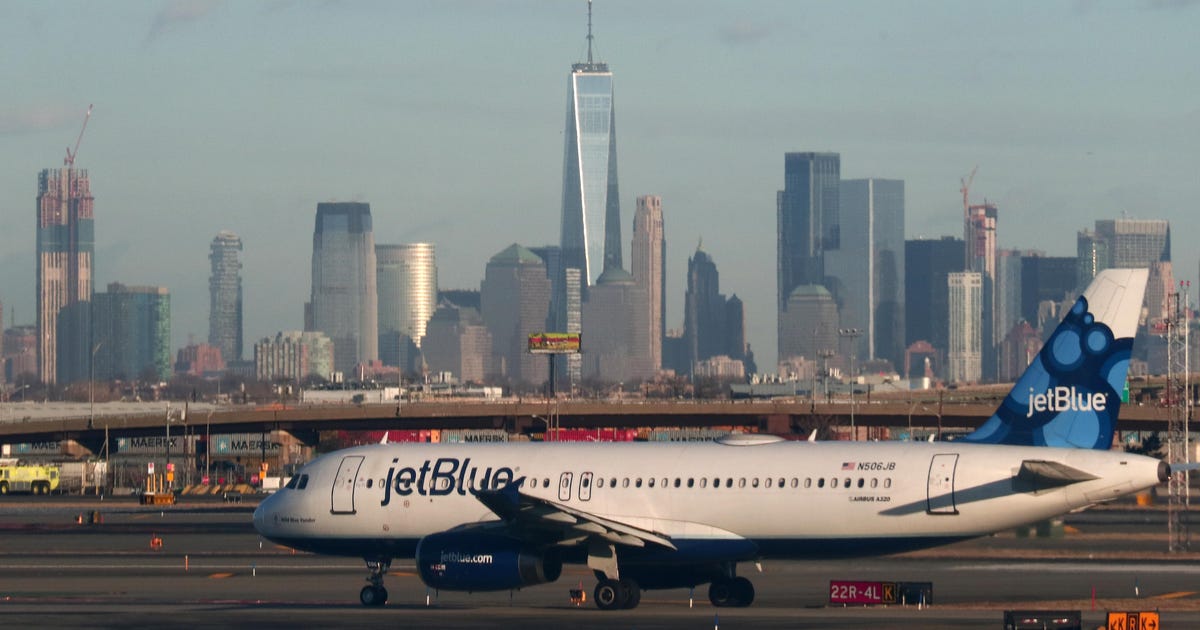[ad_1]

A JetBlue airplane readies for take-off with downtown New York Metropolis within the background.
James Martin/CNET
The Federal Aviation Administration has launched an inventory of airports that can have non permanent buffer zones round them that can ban new 5G protection set to go dwell later in January for a interval of six months. In that point, the company and aviation business will work to make sure present plane tools will not be disrupted by the brand new frequencies carriers will use to increase their 5G networks.
The record of airports consists of a number of the largest worldwide hubs throughout the US, like John F. Kennedy Worldwide in New York Metropolis, Los Angeles Worldwide and Chicago’s O’Hare Worldwide. They embody areas the place carriers plan to activate 5G protection within the so-called C-band of frequencies on Jan. 19. Site visitors quantity, the variety of low-visibility days and geographic location all factored into which airports would require buffer zones, in keeping with an FAA newsroom post on Friday.
For six months after C-band goes dwell, wi-fi firms together with AT&T and Verizon will swap off transmitters and make different changes to C-band 5G sign within the 3.7-3.98GHz frequencies round airports in these buffer zones. That may hold them from interfering with aviation tools working within the 4.2-4.4GHz frequencies.
That tools consists of radio altimeters, which offer correct top readings to plane techniques, together with navigation and collision avoidance. The FAA and aviation business have been involved that C-band sign will intervene with readings that plane depend on when touchdown at airports throughout tough climate and low visibility.
Within the six months that the buffer zones are energetic, the FAA will work with airways and producers to check altimeters working amid C-band 5G sign and raise restrictions on plane utilizing altimeters which are protected to fly in these environments. Those who aren’t will probably be retrofitted or changed, in keeping with an FAA C-band FAQ page.
The non permanent buffer zones embody barely greater than a mile round touchdown runways that utterly ban C-band 5G sign, offering planes with 20 seconds of signal-free time whereas they arrive in for touchdown.
The wi-fi business has a extra particular define for the zones, which can lengthen for two,100 meters in entrance of and behind runways, in addition to 910 meters on both aspect. Carriers will cut back C-band sign in a narrower 6,100-meter path forward of and behind runways and restrict sign energy above the horizon, in keeping with a doc offered to CNET by the CTIA, a commerce group representing the wi-fi business.
The buffer zones are one other compromise made by US carriers to make sure their upcoming C-band service does not intervene with essential plane devices. Verizon and AT&T delayed their C-band launches in November and once more January, in addition to decreasing broadcasted power levels nationwide. That is the primary we’re seeing of a timeline that satisfies each the wi-fi and aviation industries and companies, which have been engaged on an answer to the problem for the reason that FCC auctioned off the C-band frequencies to US carriers in February 2020.
The complete record of airports that can have buffer zones for six months after Jan. 19 are as follows:
- Austin-Bergstrom Worldwide Airport in Austin, Texas
- Laurence G. Hanscom Discipline in Bedford, Massachusetts
- King County Worldwide Airport in Seattle, Washington
- Birmingham-Shuttlesworth Worldwide Airport in Birmingham, Alabama
- Nashville Worldwide Airport in Nashville, Tennessee
- Bob Hope Airport in Burbank, California
- Akron-Canton Airport in Canton, Ohio
- Charlotte Douglas Worldwide Airport in Charlott, North Carolina
- Dallas Love Discipline in Dallas
- Dallas/Fort Price Worldwide Airport in Dallas-Fort Price metroplex
- Detroit Metropolitan Wayne County Airport in Detroit
- Ellington Airport in Houston
- Newark Liberty Worldwide Airport in Newark, New Jersey
- Fresno Yosemite Worldwide Airport in Fresno, California
- Fort Lauderdale-Hollywood Worldwide Airport in Fort Lauderdal, Florida
- Bishop Worldwide Airport in Flint, Michigan
- William P. Pastime Airport in Houston
- Tweed-New Haven Regional Airport in New Haven, Connecticut
- George Bush Intercontinental Airport in Houston
- Indianapolis Worldwide Airport in Indianapolis
- Lengthy Island MacArthur Airport in Ronkonkom, New York
- John F. Kennedy Worldwide Airport in New York Metropolis
- Harry Reid Worldwide Airport in Las Vegas
- Los Angeles Worldwide Airport in Los Angeles
- LaGuardia Airport in New York Metropolis
- Lengthy Seashore Airport in Lengthy Seashore, California
- Kansas Metropolis Worldwide Airport in Kansas Metropolis
- Orlando Worldwide Airport in Orlando, Florida
- Harrisburg Worldwide Airport in Middletown, Pennsylvania
- Chicago Halfway Worldwide Airport in Chicago
- McAllen Worldwide Airport in McAllen, Texas
- Miami Worldwide Airport in Miami
- Minneapolis-Saint Paul Worldwide Airport in Minnesota
- Ontario Worldwide Airport in Ontario, California
- O’Hare Worldwide Airport in Chicago
- Paine Discipline in Snohomish County, Washington
- Palm Seashore Worldwide Airport in West Palm Seashore, Florida
- Philadelphia Worldwide Airport in Philadelphia
- Phoenix Sky Harbor Worldwide Airport in Phoenix
- St. PeteClearwater Worldwide Airport in Clearwate, Florida
- Pittsburgh Worldwide Airport in Pittsburgh
- Raleigh-Durham Worldwide Airport in Morrisvill, North Carolina
- Frederick Douglass – Higher Rochester Worldwide Airport in Rocheste, New York
- Seattle-Tacoma Worldwide Airport in Seattle
- San Francisco Worldwide Airport in San Francisco
- Norman Y. Mineta San Jose Worldwide Airport in San Jose, California
- John Wayne Airport in Santa Ana, California
- St. Louis Lambert Worldwide Airport in St. Louis
- Syracuse Hancock Worldwide Airport in Syracus, New York
- Teterboro Airport in Teterbor, New Jersey
[ad_2]
Source link

